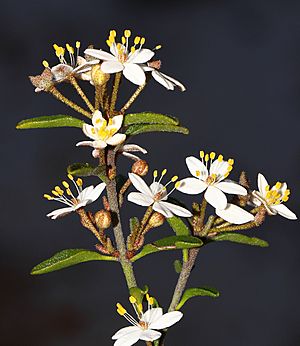Gairdner Range starbush facts for kids
Quick facts for kids Gairdner Range starbush |
|
|---|---|
 |
|
| Near Dandaragan | |
| Conservation status | |
| Scientific classification | |
| Genus: |
Asterolasia
|
| Species: |
drummondii
|
| Synonyms | |
The Gairdner Range starbush (scientific name: Asterolasia drummondii) is a small shrub. It grows only in a specific part of southwestern Western Australia. This plant has leaves shaped like eggs. Its white flowers grow in clusters of five to ten. The back of the flower petals has cool, rust-coloured, star-shaped hairs.
Contents
What Does the Starbush Look Like?
The Gairdner Range starbush is a woody shrub. It usually grows to be about 20 to 50 centimetres (8 to 20 inches) tall. This plant is a perennial, meaning it lives for more than two years.
Its leaves are tough and feel like leather. They are shaped like an egg and are 10 to 20 millimetres (0.4 to 0.8 inches) long. The leaves are also smooth, meaning they don't have any hairs.
The flowers grow in groups of five to ten. These groups are called umbels. They are mostly found at the ends of the branches. Each flower sits on a small stalk called a pedicel. These stalks are 10 to 20 millimetres long and are covered with rust-coloured, star-shaped hairs.
The petals of the flowers are white and broadly oval. They are about 6 millimetres (0.2 inches) long. The back of the petals also has those unique rust-coloured, star-shaped hairs. Each flower has ten stamens, which are the parts that produce pollen.
How Did the Starbush Get Its Name?
The Gairdner Range starbush has an interesting naming story. In 1855, a scientist named William Henry Harvey first officially described the species. He used notes from an earlier, unpublished description by James Drummond.
Harvey first named the plant Urocarpus phebalioides. This description was published in a science journal called Hooker's Journal of Botany and Kew Garden Miscellany. The plants used for this description were found near Mount Lesueur.
Later, in 1987, another scientist named Paul Wilson moved the species to a different group, or genus, called Asterolasia. However, there was already a plant named Asterolasia phebalioides. To avoid confusion, Wilson changed the name of this specific plant to Asterolasia drummondii. He published this new name in the journal Nuytsia.
Where Does the Starbush Live?
The Gairdner Range starbush grows in a special type of soil called laterite. This soil is found on hills, flat sandy areas (sandplains), and rocky cliffs (breakaways). You can find this plant mainly in the Mount Lesueur area of Western Australia.
Is the Starbush Protected?
Yes, the Gairdner Range starbush is a protected plant. The Government of Western Australia's Department of Parks and Wildlife has classified it as "Priority Four".
This "Priority Four" status means the plant is rare or close to becoming threatened. It's important to protect these plants so they can continue to grow in their natural habitat.


